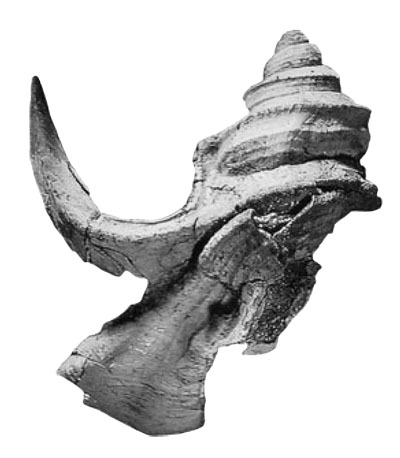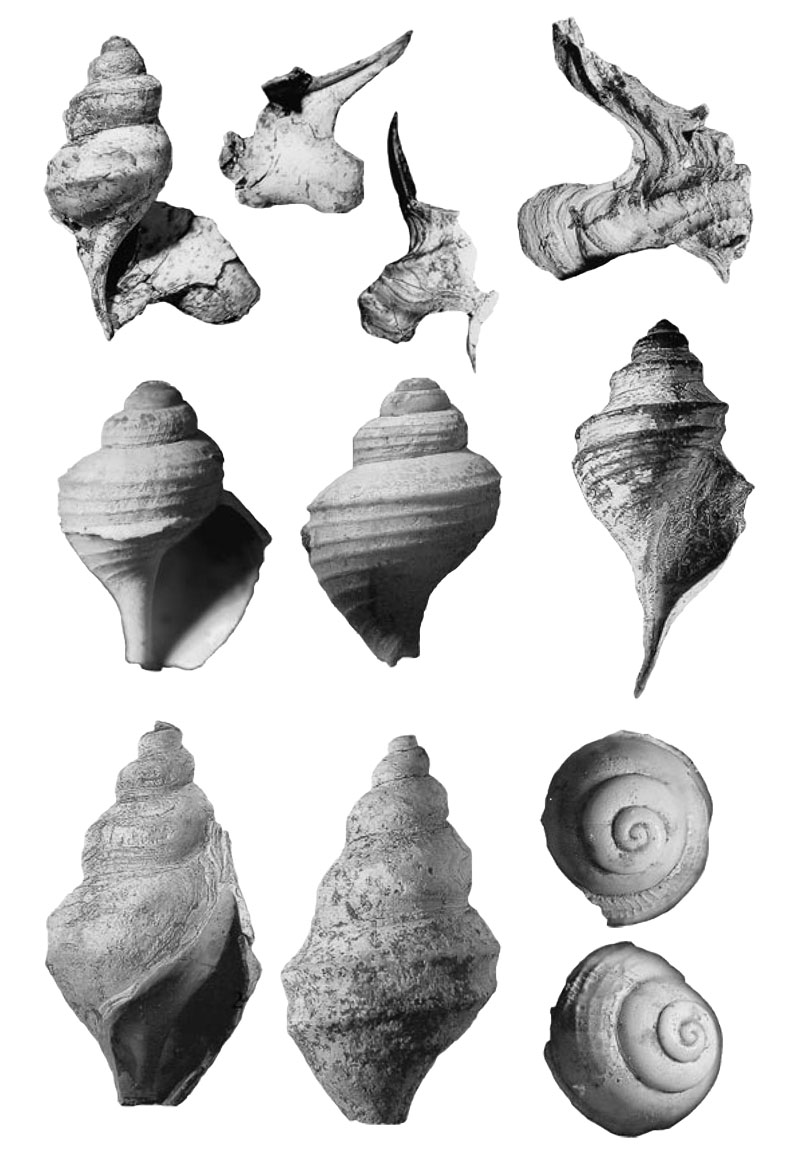|
edit SideBar
|
Species / Trilemma Russiense
Stromboidea
Original Description of Trilemma russiense by Blagovetshenskiy & Shumilkin, 2006:
- ”The shell is of medium size, fusiform, with a winglike extension of the palatal margin of the aperture, and consists of eight or nine bicarinate whorls. In the spire whorls the lower carina usually runs just over the suture and, thus, is poorly seen. On the last whorl both carinae are equally well expressed. In addition, some large individuals show rudiments of a third carina at the base of the last whorl, below the two main carinae. The surfaces of the whorls are concave between the two main carinae and slightly concave or flat above and under the carinae. The height of each spire whorl is 1.8–2.3 of the preceding. The ratio of the width of the last whorl measured above the aperture to the height of the last whorl above the aperture is 2.5–3.0. The apical angle is 80º–85º. The generating line is slightly convex. The protoconch consists of 3.3–3.5 whorls. The first whorl is smooth apically, then weak spiral costellae appear, and the first elements of axial ornamentation appear within 0.1 whorl. The boundary between the protoconch and teleoconch is poorly defined and is arbitrarily determined by the appearance of the surface ornamentation. The fourth and fifth spire whorls contain five or six or, rarely, seven spiral costae each, of which the third (counting from the adapical suture) is slightly larger than the others and develops a carina-like appearance on the sixth whorl (upper carina). In adult specimens with a well-developed winglike extension, this carina passes into a posterolateral process. At the end of the sixth–beginning of the seventh whorls, the fifth (counting from the adapical suture) spiral costa becomes more robust to make the second (lower) carina more prominent. In adult individuals, it continues on the anterolateral process. Between the upper and lower carinae, a weak spiral costella persists (the fourth counting from the upper carina) and, occasionally, one more such costella (secondary, i.e., formed during the development of the teleoconch) appears. In adult individuals, two more spiral costa (sixth and seventh), which were earlier obscured by overlapping whorls, become visible on the spire below the second carina. This is due to the increased whorl height. Above the upper carina the surface of whorls is flat or slightly concave, with two weak spiral costellae, which correspond to the first and second costae of the early whorls. On the last whorl, under the second carina, adult individuals have eight or nine spiral costellae; young individuals, six or seven. The fourth whorl gives rise to axial ornamentation in the form of costellae that are bent rightward. The angulation of the axial costellae occurs at the level of the third spiral costa; on the fifth whorl, at the level of the upper carina. The axial costellae are approximately three times as narrow as the spiral costellae and considerably lower, i.e., ornamentation is of a decussate type. The intersecting costellae of the spiral and axial ornamentations form rhomboid meshes. The axial ornamentation can only be clearly traced up to the fifth whorl. On the later whorls it is hardly visible even in well-preserved specimens. Only the upper carina shows fragments of axial costellae in the form of elongated tubercles. The aperture is elongated and elliptical and passes into a parietal canal adapically. The posterior process (in adult specimens) and the lower part of the adapical spire whorl coalesce. The upper part of the posterior process is lost; however, it probably rose higher than the initial whorls of the shell. The anterior process (rostrum) is fairly long, somewhat backwardly curved. The palatal margin of the aperture extends to form a winglike structure and have two processes, posterolateral and anterolateral. The posterolateral process continues the upper carina. It is typically sickle-shaped, is directed rightward and upward, stops short of the upper whorls of the shell, and has a notch on the apertural side. In certain specimens the posterolateral process is directed slightly upward or even nearly horizontally. The anterolateral process is wide, flat, rounded or somewhat angular at the end, expanded, and is directed rightward and downward. In the upper part of this process, there is an extension of the lower carina, under this extension there are extensions of six to nine spiral costae. The columellar and parietal margins of the aperture have a smooth, bright surface, which has preserved its initial brown color in certain individuals. The umbilicus is absent.”
Locus typicus: Novaya Beden’ga, Ulyanovsk Region, Russia
Stratum typicum: Versicolor zone, upper Hauterivian, lower Cretaceous
Holotype: UKM (Ulyanovsk Regional Museum of Regional Studies), no. 432
Trilemma russiense Blagovetshenskiy & Shumilkin, 2006; Holotype; bed g-4.1, Versicolor zone, upper Hauterivian, lower Cretaceous; Novaya Beden’ga, Ulyanovsk Region, Russia; Coll. UKM no. 432; height 15.1 mm; Picture used with permission of Springer Earth Sciences, License Number 2497160956010; Copyright Springer Earth Sciences
Trilemma russiense Blagovetshenskiy & Shumilkin, 2006; bed g-4.1, Versicolor zone, upper Hauterivian, lower Cretaceous; Novaya Beden’ga, Ulyanovsk Region, Russia; Picture used with permission of Springer Earth Sciences, License Number 2497160956010; Copyright Springer Earth Sciences
Localities:
- First ligne: village of Novaya Beden’ga, Ulyanovsk Region, Russia
- Second ligne: small town of Slantsevyi Rudnik, Ulyanovsk Region, Russia
- Third ligne: small town of Slantsevyi Rudnik, Ulyanovsk Region, Russia; Protoconches: village of Novaya Beden’ga, Ulyanovsk Region, Russia
References:
|


